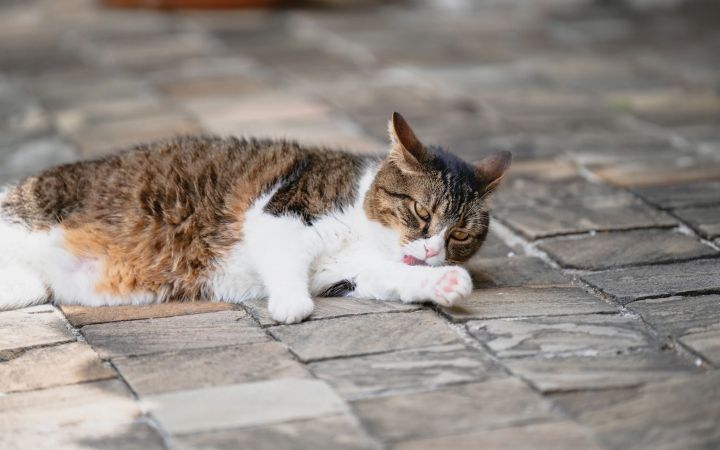

Cats are very sensitive to their environment, but they’re also good at hiding when something is wrong. As a result, it can be easy to miss the signs of stress in cats, like overgrooming or urinating outside the litter tray. Knowledge is key to helping your feline friend, so read on to learn what signs to look for and how to help reduce stress in cats.
Understanding cat overgrooming as a sign of stress
Cats love to keep clean, so it’s not unusual to see your cat grooming themselves regularly. However, cat overgrooming (very frequent or long grooming sessions) can be a sign that your cat is anxious or stressed. Grooming releases feel-good endorphins that can help the cat to self-soothe, but for some cats this behaviour can become compulsive.
Cat urinating outside the litter tray?

Urinating outside of the litter tray is another possible sign of stress in cats.
Cats may urinate outside of the litter tray due to stressful changes to their toileting environment. These might include a dirty litter tray, a change of location or type of litter, an increase in noise, or any other environmental change that could disturb your cat. In this case, cats will usually urinate on horizontal surfaces like carpets and floors.
If you notice your cat urinating deliberately in the home, mostly on vertical surfaces, they could be marking or spraying. This refers to a type of marking where cats spray urine onto a vertical surface like a wall. Urine contains pheromones unique to your cat, so urinating can be a way to mark their territory.
Some urine diseases may also lead to a sign of stress, so it’s best to check with your vet before concluding this is a stress issue.
Other signs of stress in cats
Changes in behaviour can be an indication that your cat is stressed. Here are some examples:
- Excessive scratching of objects
- Excessive meowing or howling
- Withdrawing or hiding
- Aggression towards people or pets
- Reluctance to come inside or go outside/change in routine
- Increased vigilance and jumpiness
- Lack of responsiveness
- Wanting much more or less affection than usual
- Loss of interest in play or hunting
Every cat is different; the key is to know what’s normal for your cat so you can spot when something changes and give them the support they need.
How to reduce stress in cats
To calm an anxious cat, you’ll need first to identify the stressor. Here are some of the most common causes of stress and anxiety for our feline friends:
- Other pets being introduced to the home
- Competition for resources with other cats
- Unfamiliar cats on the property or in the neighbourhood
- Aggressive behaviour from strays or unneutered cats
- Lack of quality nutrition, fresh water, play or exercise
- A dirty or cramped litter tray
- Noisy environments, especially around eating, resting or toileting areas
- Unwanted attention or rough handling
- New household members, especially children and babies
- A house move or renovation
- Lots of guests
- Changes in routine e.g. working from home
The next step is to make positive changes to eliminate or minimise the impact of the stressor. For example, you could:
- Provide one more litter tray, bowl and bed than the number of cats in the home and ideally spread them out over the house.
- Remove dirty litter daily and deep clean the tray every week.
- Avoid litter trays with flap doors that may frighten your cat
- Keep litter trays away from food and water bowls, and keep both in quiet areas
- Make sure the litter tray is of a decent size
- Provide toys and activities for mental stimulation
- Give your cat a quiet, safe space to retreat from potential stressors
- Use microchip pet doors to keep other cats out
- Consider housing sensitive cats with friends or a trusted cattery during stressful times like moving home
- Keep routines as predictable as possible, especially during times of change
- Entertain guests away from your cat’s quiet spot
- Get your cat used to the changes before the arrival of a new family member e.g. a baby. Get them accustomed to the new items, furniture and home layout, and play baby noise recording to familiarise them with the new sounds
- Always supervise children and babies around your cat and guide them on gentle handling and space
- Use pheromone products to calm your cat
How to calm a stressed cat with pheromones
Cats deposit pheromones in their urine to let other cats know that this is their territory. But cats also deposit pheromones via facial glands to mark things in their environment as safe. That’s why your cat will often rub their face on you, your furniture, or even other pets. When they catch that familiar scent, they know they’re in safe territory.
Artificial pheromones mimic this natural calming effect, making your cat feel safe and secure. They come in a range of products designed for different uses, such as sprays, collars, and diffusers.
When to consult a vet

The signs of stress can be mistaken for the signs of other illnesses. For example, cat overgrooming can be caused by allergies, flea infestation or other skin conditions, while urinating outside the litter tray can be caused by kidney, urinary tract diseases or diabetes.
We always recommend a visit to your vet if you notice stress-related signs in your cat. This is especially important if your cat is showing signs like pain, bloody urine, diarrhoea or weight changes. Your vet will be able to diagnose and treat any underlying illnesses, and will be able to recommend a behavioural specialist if needed.